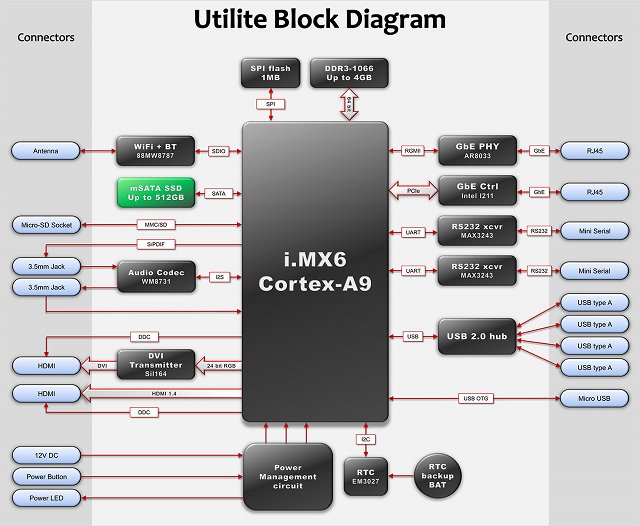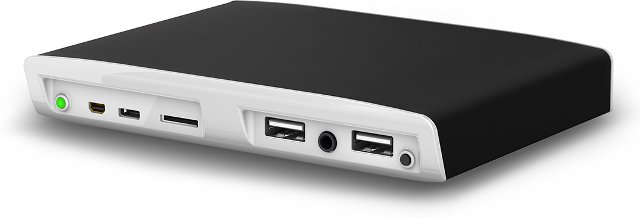If you’re ready to tinker it’s possible to run Linux in one of the low cost ARM based set-top boxes or mini PCs currently available, although if you need Linux with 3D acceleration and video playback, your only realistic option is to go with solutions based on Freescale i.MX6. Compulab has been developing a mini desktop computer based on Freescale i.MX6 Solo, Dual or Quad that will run either Ubuntu or Android, so you don’t need to mess around to run Ubuntu on cheap ARM hardware. The device is expected to sell for $99 and up starting in August according to Fanlesstech.
Compulab Utilite will have the following specifications:
- SoC – Freescale i.MX6 single / dual / quad core Cortex-A9 up to 1.2GHz, with Vivante GPU, and Video Processing Unit supporting multi-stream 1080p H.264, VC1, RV10, DivX HW decoding
- System Memory – Up to 4GB DDR3-1066
- Storage – 1MB SPI flash, mSATA SSD (up to 512GB) + micro-SD SDXC slot (up to 128GB)
- Video Output:
- Primary Display – HDMI 1.4 up to 1920 x 1200 @ 60Hz
- Secondary Display DVI-D up to 1920 x 1200 @ 60Hz
- Audio I/O – Audio S/PDIF 5.1 (electrical through 3.5mm jack), Stereo line-out, Stereo line-in
- Connectivity:
- 2x 1000 BaseT Ethernet ports
- WiFi 802.11b/g/n Wi-Fi, single antenna
- Bluetooth Bluetooth 3.0 (88MW8787)
- USB – 4x USB 2.0 host ports, 1x micro USB OTG
- Serial – Two RS232 serial ports, ultra mini serial connector
- Dimensions – 135mm x 100mm x 21mm
- Power Supply – Unregulated 10 to 16 volt input
- Power 3W – 8W (depending on system configuration and load)
- Operating Temperature – 0C – 45C
We’ve got dual Gigabit Ethernet, dual (independent?) displays, SATA support, up to 4GB memory… That looks like a very interesting product. Apart from 1MB internal flash, there’s no other storage with the device, so I assume it may be sold with an internal SSD or microSD card pre-loaded with Android or Ubuntu.
You can get an overview of the internals, including the name of some of the chips used, in the block diagram below. On a side note, the company also provides CM-FX6 computer-on-modules based on i.MX6 Solo/Dual/Quad, so they may or may not have used it inside the Utilite (TBC).

Compulab is known for its Trim-slice (Tegra 2) and FitPC (x86) fanless Linux computers, and has provided hardware and software resources for both devices. For example, for the Trimslice, you can download the user and reference manuals, mechanical and board drawing, as well as access OS binary images, and source code for the bootloader and the Linux kernel. So I’d expect them to do the same for Utilite via utilite-computer.com.
Provided it does feature all connectivity and video capabilities listed in the specs above, the $99 base version will truly be a unique product in the market. However, higher end versions (quad core, more memory) may be sold at a price that competes directly with x86 based solutions, and low power consumption will be the main advantage.
Via Liliputing

Jean-Luc started CNX Software in 2010 as a part-time endeavor, before quitting his job as a software engineering manager, and starting to write daily news, and reviews full time later in 2011.
Support CNX Software! Donate via cryptocurrencies, become a Patron on Patreon, or purchase goods on Amazon or Aliexpress






